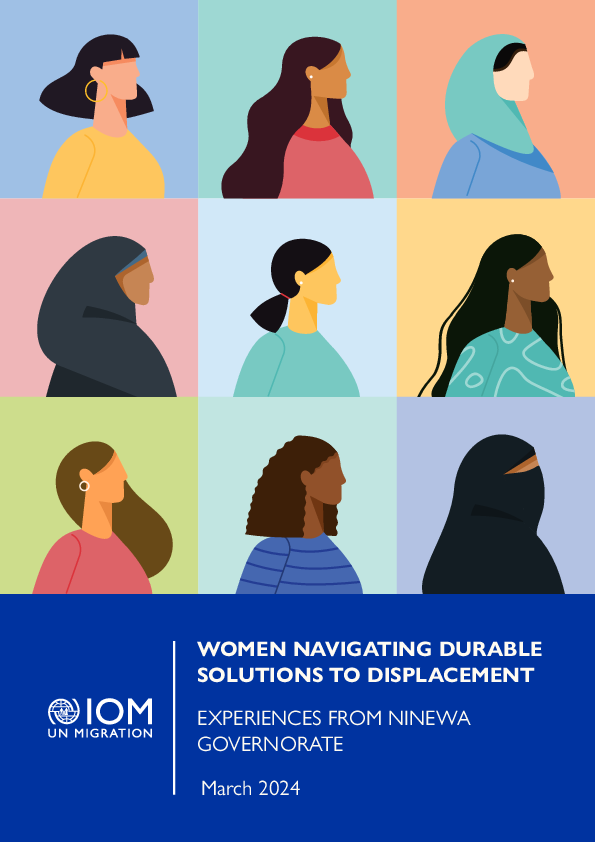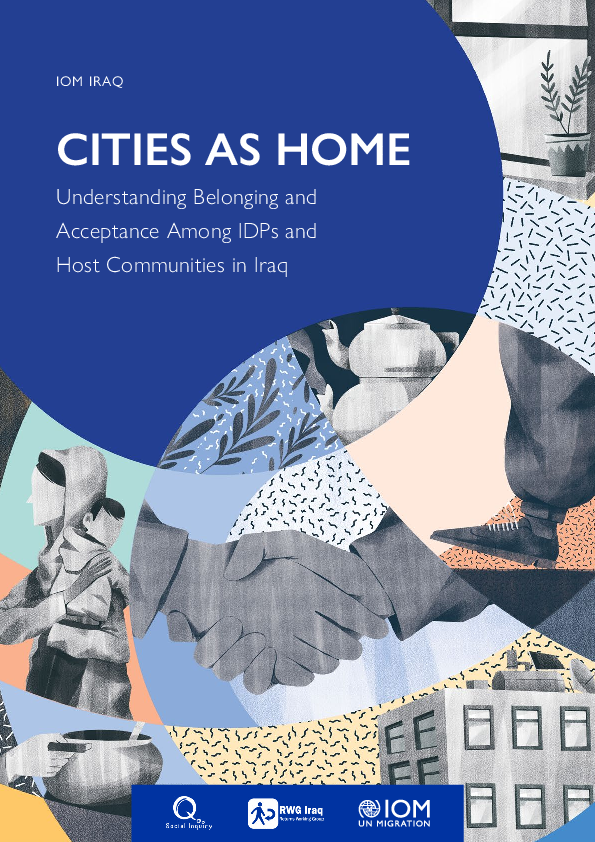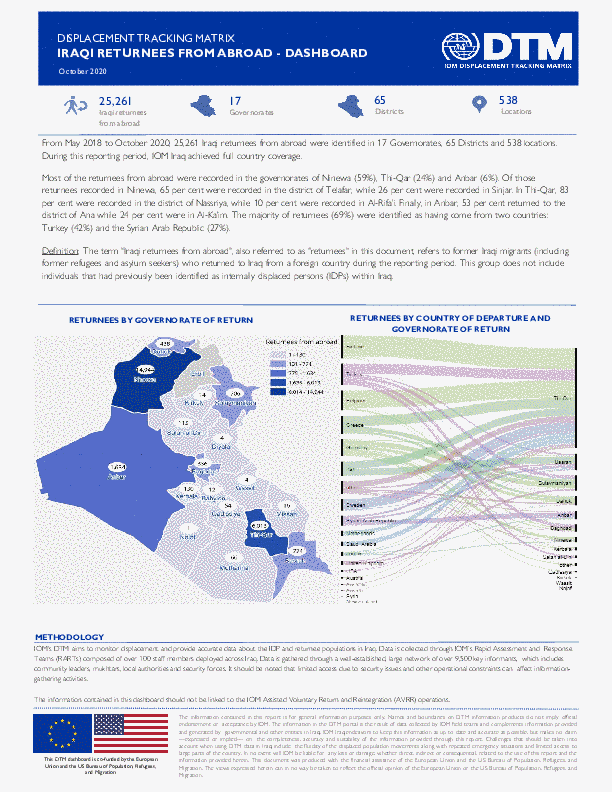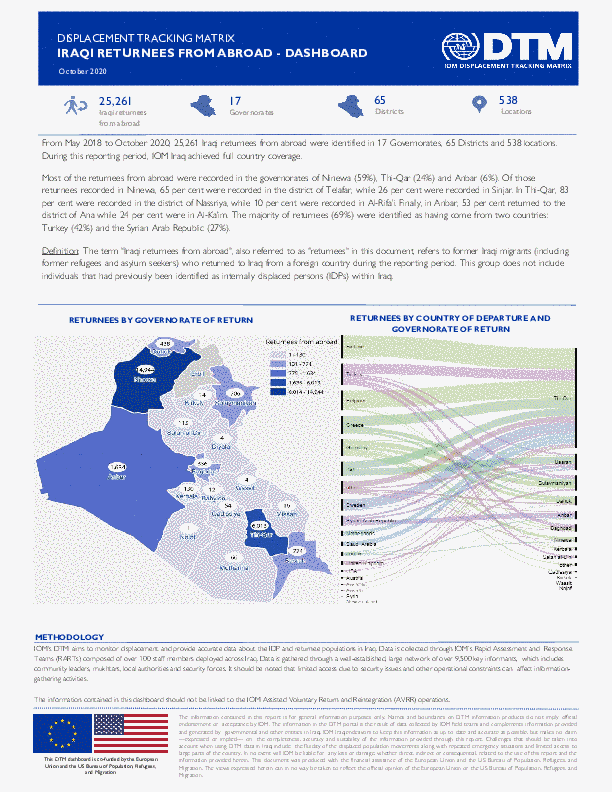-
Countries
-
Data and Analysis
-
Special Focus
-
Crisis Responses

Contact
DTM Iraq, IraqDTM@iom.int
Language
English
Location
Iraq
Period Covered
Jun 11 2023
Jun 20 2023
Activity
- Survey
- Displacement Solutions
The Women Navigating Durable Solutions report explores what factors influence decision-making during the durable solution process, as well as women’s agency to overcome reintegration barriers. The objective of this study is to investigate the experience of displaced women and their reintegration in areas of origin. It examines female-related vulnerabilities and obstacles that affect their reintegration

Contact
DTM Iraq, IraqDTM@iom.int
Language
English
Location
Iraq
Period Covered
Jan 01 2019
Dec 31 2020
Activity
- Survey
- Displacement Solutions
In order to contribute to the measurement of local integration of internally displaced persons (IDPs) in Iraq, IOM Iraq, the Returns Working Group, and Social Inquiry implemented an in-depth study of 14 urban locations in the country hosting a high density of families displaced due to the ISIL conflict. A complementary forthcoming study on Urban Displacement in Iraq, by IOM Iraq DTM, explores protracted urban displacement, including an examination of IDP intentions. Utilising data collected on IDPs' perceptions and living conditions in displacement (1,382 respondents) and on those of host community residents (1,437 respondents) in the same neighbourhoods as well as key informant interviews with local authorities and policy-implementers (40 interviews) in these areas, this work seeks to identify which factors help or hinder local integration – and those locations that are more (or less) conducive to this outcome. This study is predicated on the understanding that local integration is not only based how on IDPs perceive their own belonging in the hosting location, irrespective of any stated intentions to stay or return, but also how host communities feel about accepting them. Further to this, these feelings may themselves be influenced by the character of the urban areas where IDPs and host communities reside as well as the regulatory environment surrounding them.
This report is part of a larger research project, Cities as Home, carried out by IOM Iraq, the Returns Working Group, and Social Inquiry, that explores both drivers and deterrents of integration across 14 urban locations that still host the largest share of IDPs in the country. The outputs of this project also include factsheets for each location, four detailed case studies, and a brief on COVID-19 regulations and implications for local integration

Contact
DTM Iraq, IraqDTM@iom.int
Language
English
Location
Iraq
Period Covered
May 01 2018
Aug 31 2020
Activity
- Mobility Tracking
- Baseline Assessment
From May 2018 to August 2020, 23,457 Iraqi returnees from abroad were identified in 16 Governorates, 61 Districts and 538 locations. During this reporting period, IOM Iraq achieved full country coverage. Most of the returnees from abroad were recorded in the governorates of Ninewa (63%), Thi-Qar (19%) and Anbar (7%). Of those returnees recorded in Ninewa, 65 per cent were recorded in the district of Telafar, while 26 per cent were recorded in Sinjar. In Thi-Qar, 80 per cent were recorded in the district of Nassriya, while 12 per cent were recorded in Al-Rifa'i. Finally, in Anbar, 53 per cent returned to the district of Ana while 24 per cent were in Al-Ka'im. The majority of returnees (73%) were identified as having come from two countries: Turkey (44%) and the Syrian Arab Republic (29%)

Contact
DTM Iraq, IraqDTM@iom.int
Language
English
Location
Iraq
Period Covered
May 01 2018
Oct 31 2020
Activity
- Mobility Tracking
- Baseline Assessment
From May 2018 to October 2020, 25,261 Iraqi returnees from abroad were identified in 17 Governorates, 65 Districts and 538 locations. During this reporting period, IOM Iraq achieved full country coverage. Most of the returnees from abroad were recorded in the governorates of Ninewa (59%), Thi-Qar (24%) and Anbar (6%). Of those returnees recorded in Ninewa, 65 per cent were recorded in the district of Telafar, while 26 per cent were recorded in Sinjar. In Thi-Qar, 83 per cent were recorded in the district of Nassriya, while 10 per cent were recorded in Al-Rifa'i. Finally, in Anbar, 53 per cent returned to the district of Ana while 24 per cent were in Al-Ka'im. The majority of returnees (69%) were identified as having come from two countries: Turkey (42%) and the Syrian Arab Republic (27%

Contact
DTM Iraq, IraqDTM@iom.int
Language
English
Location
Iraq
Period Covered
May 01 2018
Dec 31 2020
Activity
- Mobility Tracking
- Baseline Assessment
From May 2018 to December 2020, 27,325 Iraqi returnees from abroad were identified in 17 Governorates, 65 Districts and 560 locations. During this reporting period, IOM Iraq achieved full country coverage. Most of the returnees from abroad were recorded in the governorates of Ninewa (56%), Thi-Qar (29%) and Anbar (6%). Of those returnees recorded in Ninewa, 66 per cent were recorded in the district of Telafar, while 25 per cent were recorded in Sinjar. In Thi-Qar, 85 per cent were recorded in the district of Nassriya, while 8 per cent were recorded in Al-Rifa'i. Finally, in Anbar, 53 per cent returned to the district of Ana while 24 per cent were in Al-Ka'im. The majority of returnees (65%) were identified as having come from two countries: Turkey (40%) and the Syrian Arab Republic (25%)

Contact
DTM Iraq, IraqDTM@iom.int
Language
English
Location
Iraq
Period Covered
May 01 2018
Feb 28 2021
Activity
- Mobility Tracking
- Baseline Assessment
From May 2018 to February 2021, 29,335 Iraqi returnees from abroad were identified in 17 Governorates, 65 Districts and 582 locations. During this reporting period, IOM Iraq achieved full country coverage. Most of the returnees from abroad were recorded in the governorates of Ninewa (53%), Thi-Qar (32%) and Anbar (6%). Of those returnees recorded in Ninewa, 66 per cent were recorded in the district of Telafar, while 25 per cent were recorded in Sinjar. In Thi-Qar, 86 per cent were recorded in the district of Nassriya, while 7 per cent were recorded in Suq Al-Shoyokh. Finally, in Anbar, 53 per cent returned to the district of Ana while 24 per cent were in Al-Ka'im. The majority of returnees (62%) were identified as having come from two countries: Turkey (39%) and the Syrian Arab Republic (23%)

Contact
DTM Iraq, IraqDTM@iom.int
Language
English
Location
Iraq
Period Covered
May 01 2018
Apr 30 2021
Activity
- Mobility Tracking
- Baseline Assessment
Between May 2018 and April 2021, a total of 31,212 Iraqi returnees from abroad were identified in 17 governorates, 66 districts and 590 locations. During this reporting period, IOM Iraq achieved full country coverage. Most of the returnees from abroad were recorded in the governorates of Ninewa (50%), Thi-Qar (36%) and Anbar (5%). Of those returnees recorded in Ninewa governorate, 66 per cent were recorded in the district of Telafar, while 25 per cent were recorded in Sinjar. In Thi-Qar governorate, 87 per cent were recorded in the district of Nassriya, while 7 per cent were recorded in Suq Al-Shoyokh. Finally, in Anbar governorate, 51 per cent returned to the district of Ana and 26 per cent returned to Al-Ka'im. The majority of returnees (60%) were identified as having come from two countries: Turkey (38%) and the Syrian Arab Republic (22%)

Contact
DTM Iraq, IraqDTM@iom.int
Language
English
Location
Iraq
Period Covered
May 01 2018
Jul 31 2021
Activity
- Mobility Tracking
- Baseline Assessment
From May 2018 to July 2021, 33,098 Iraqi returnees from abroad were identified in 17 Governorates, 67 Districts and 595 locations. During this reporting period, IOM Iraq achieved full country coverage. Most of the returnees from abroad were recorded in the governorates of Ninewa (48%), Thi-Qar (39%) and Anbar (5%). Of those returnees recorded in Ninewa, 66 per cent were recorded in the district of Telafar, while 24 per cent were recorded in Sinjar. In Thi-Qar, 88 per cent were recorded in the district of Nassriya, while 7 per cent were recorded in Suq Al-Shoyokh. Finally, in Anbar, 51 per cent returned to the district of Ana while 26 per cent were in Al-Ka'im. The majority of returnees (58%) were identified as having come from two countries: Turkey (37%) and the Syrian Arab Republic (21%).

Contact
DTM Iraq, IraqDTM@iom.int
Language
English
Location
Iraq
Period Covered
Mar 01 2016
Jun 30 2021
Activity
- Survey
- Community Perception
- Displacement Solutions
- Return Intention
- Mobility Tracking
- Baseline Assessment
What happens to households experiencing protracted displacement during a global pandemic? This is not a question that Access to Durable Solutions Among IDPs in Iraq, a panel study conducted by IOM and Georgetown University, initially anticipated answering at its inception six years ago.1 Yet this question is one the study is uniquely positioned to answer. The mixed-method project collects data from surveys and interviews to understand how the same Iraqi IDP households displaced by the conflict with the Islamic State in Iraq and the Levant (ISIL) try to access a “durable solution” to their displacement as defined by the Inter-Agency Standing Committee’s Framework on Durable Solutions. Conducted among the non-camp population of IDPs displaced between 2014 and 2015, the study operationalized the eight criteria that collectively measure a durable solution: safety and security, standard of living, livelihood, housing, access to documentation, family reunification, participation in public affairs, and access to justice. Using each of these criteria over six rounds of data collection, the study has tracked changes in what challenges IDP households face and the solutions they engineer as they search for a durable solution to their displacement. Based on findings from the newest, sixth round of data collection, this report details not only how COVID-19 affects IDPs, but specifically, and in keeping with the purpose of the study, how the COVID-19 pandemic affected IDP households’ abilities to achieve a durable solution. This latter endeavor entails two tasks: first, to identify what challenges persist because they existed pre-COVID-19 (and are thus primarily displacement-related), and second, to identify what challenges the COVID-19 pandemic has created or made worse. The longitudinal nature of the Access to Durable Solutions study and its ability to compare current findings with past trends using the same indicators facilitated disentangling and completing these two tasks

Contact
DTM Iraq, IraqDTM@iom.int
Language
English
Location
Iraq
Snapshot Date
Sep 30 2017
Activity
- Survey
- Community Perception
- Displacement Solutions
In order better to understand what the local integration of internally displaced persons (IDPs) may look like in Iraq, IOM Iraq, the Returns Working Group (RWG), and Social Inquiry implemented a targeted in-depth study in Sulaymaniyah and Baghdad Governorates. Utilizing data on IDPs’ perceptions and living conditions in displacement from those displaced more than three years (762 respondents) and data collected among host community residents (800 respondents) in the same neighbourhoods and towns in these governorates, this work seeks to identify which factors help or hinder local integration.
The findings presented herein highlight that socioeconomic, cultural, and spatial factors at the individual and structural levels matter for integration and acceptance. Most of the evidence collected here points to the fact that better integration and acceptance is found among more socioeconomically equal communities, those with strong but more elastic social cohesion, and in places where host communities feel historical grievances related to violence and conflict have been dealt with satisfactorily